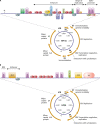The EVER proteins as a natural barrier against papillomaviruses: a new insight into the pathogenesis of human papillomavirus infections
- PMID: 19487731
- PMCID: PMC2698414
- DOI: 10.1128/MMBR.00033-08
The EVER proteins as a natural barrier against papillomaviruses: a new insight into the pathogenesis of human papillomavirus infections
Abstract
Infections by human papillomaviruses (HPVs) are the most frequently occurring sexually transmitted diseases. The crucial role of genital oncogenic HPV in cervical carcinoma development is now well established. In contrast, the role of cutaneous HPV in skin cancer development remains a matter of debate. Cutaneous beta-HPV strains show an amazing ubiquity. The fact that a few oncogenic genotypes cause cancers in patients suffering from epidermodysplasia verruciformis is in sharp contrast to the unapparent course of infection in the general population. Our recent investigations revealed that a natural barrier exists in humans, which protects them against infection with these papillomaviruses. A central role in the function of this HPV-specific barrier is played by a complex of the zinc-transporting proteins EVER1, EVER2, and ZnT-1, which maintain cellular zinc homeostasis. Apparently, the deregulation of the cellular zinc balance emerges as an important step in the life cycles not only of cutaneous but also of genital HPVs, although the latter viruses have developed a mechanism by which they can break the barrier and impose a zinc imbalance. Herein, we present a previously unpublished list of the cellular partners of EVER proteins, which points to future directions concerning investigations of the mechanisms of action of the EVER/ZnT-1 complex. We also present a general overview of the pathogenesis of HPV infections, taking into account the latest discoveries regarding the role of cellular zinc homeostasis in the HPV life cycle. We propose a potential model for the mechanism of function of the anti-HPV barrier.
Figures






Similar articles
-
Regulation of cellular zinc balance as a potential mechanism of EVER-mediated protection against pathogenesis by cutaneous oncogenic human papillomaviruses.J Exp Med. 2008 Jan 21;205(1):35-42. doi: 10.1084/jem.20071311. Epub 2007 Dec 24. J Exp Med. 2008. PMID: 18158319 Free PMC article.
-
Deficiency in Ever2 does not increase susceptibility of mice to pathogenesis by the mouse papillomavirus, MmuPV1.J Virol. 2024 Jul 23;98(7):e0017424. doi: 10.1128/jvi.00174-24. Epub 2024 Jun 13. J Virol. 2024. PMID: 38869286 Free PMC article.
-
Human genetic dissection of papillomavirus-driven diseases: new insight into their pathogenesis.Hum Genet. 2020 Jun;139(6-7):919-939. doi: 10.1007/s00439-020-02183-x. Epub 2020 May 20. Hum Genet. 2020. PMID: 32435828 Free PMC article. Review.
-
Biology and pathological associations of the human papillomaviruses: a review.Malays J Pathol. 1998 Jun;20(1):1-10. Malays J Pathol. 1998. PMID: 10879257 Review.
-
[Genetics and susceptibility to human papillomaviruses: epidermodysplasia verruciformis, a disease model].Bull Acad Natl Med. 2010 Jun;194(6):923-40; discussion 941. Bull Acad Natl Med. 2010. PMID: 21513129 French.
Cited by
-
Risk of squamous cell skin cancer after organ transplant associated with antibodies to cutaneous papillomaviruses, polyomaviruses, and TMC6/8 (EVER1/2) variants.Cancer Med. 2014 Oct;3(5):1440-7. doi: 10.1002/cam4.280. Epub 2014 Jun 10. Cancer Med. 2014. PMID: 24913986 Free PMC article.
-
Warts and all: human papillomavirus in primary immunodeficiencies.J Allergy Clin Immunol. 2012 Nov;130(5):1030-48. doi: 10.1016/j.jaci.2012.07.049. Epub 2012 Oct 1. J Allergy Clin Immunol. 2012. PMID: 23036745 Free PMC article. Review.
-
HPV infection upregulates the expression of ZNT-1 in condyloma acuminatum.Eur J Histochem. 2021 Apr 28;65(2):3228. doi: 10.4081/ejh.2021.3228. Eur J Histochem. 2021. PMID: 33908744 Free PMC article.
-
Common dermatologic manifestations of primary immune deficiencies.Curr Allergy Asthma Rep. 2014 Dec;14(12):480. doi: 10.1007/s11882-014-0480-2. Curr Allergy Asthma Rep. 2014. PMID: 25269404 Review.
-
Treatment and Prevention of HPV-Associated Skin Tumors by HPV Vaccination.Vaccines (Basel). 2024 Dec 20;12(12):1439. doi: 10.3390/vaccines12121439. Vaccines (Basel). 2024. PMID: 39772099 Free PMC article. Review.
References
-
- Akgul, B., M. Curten, H. Haigis, I. Rogosz, and H. Pfister. 2006. Interferon regulatory factor 5.2 acts as a transcription repressor of epidermodysplasia verruciformis-associated human papillomaviruses. Arch. Virol. 1512461-2473. - PubMed
-
- Andrews, G. K., H. Wang, S. K. Dey, and R. D. Palmiter. 2004. Mouse zinc transporter 1 gene provides an essential function during early embryonic development. Genesis 4074-81. - PubMed
-
- Androphy, E. J., I. Dvoretzky, and D. R. Lowy. 1985. X-linked inheritance of epidermodysplasia verruciformis. Genetic and virologic studies of a kindred. Arch. Dermatol. 121864-868. - PubMed
Publication types
MeSH terms
Substances
LinkOut - more resources
Full Text Sources

